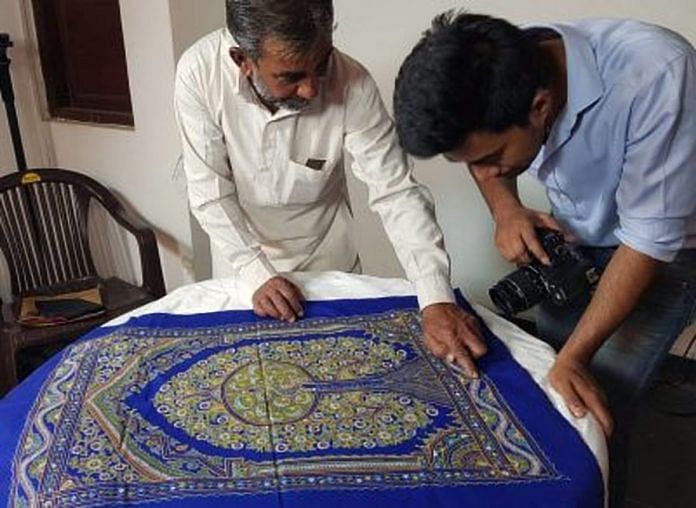After Walmart’s $16 billion investment in Flipkart, the largest internet retailer’s move of recruiting these unlikely suppliers is a sign of the fierce battle raging globally.
Abdul Gafur Khatri lives on the fringe of great salt marshes in far western India. He doesn’t own a smartphone. He’s never surfed the web. Still, the 53-year-old thinks the internet may be his last hope of reviving a fading art called Rogan that’s been passed down through eight generations of his family.
“If I can sell online, demand will go up,” says the grey-haired artisan, one of the last living custodians of a skill that uses gummy, colored pastes to paint intricate motifs on cloth.
On a blistering summer day, Khatri arrives with dozens of other craftsmen in the town of Bhuj, tucked into a remote region that abounds with handmade crafts. Amazon.com Inc. is venturing here, where no major retailer has gone before, offering workshops to initiate some of the most talented – and least tech savvy – artisans in the mysteries of online selling.
It’s a sign of the fierce battle raging globally. Amazon is recruiting these unlikely suppliers a 15-hour drive from Mumbai as it prepares to fight over the market with Walmart Inc., which just agreed to spend $16 billion for control of local e-commerce pioneer Flipkart Online Services Pvt.
With such workshops, Amazon aims to increase the appeal of its site by adding hundreds of exquisite handmade arts and crafts not available anywhere else online. It offers these classroom sessions in the sellers’ own tongue, such as Gujarati here in Bhuj. It handles payments and refunds. It enlists local wedding photographers to help snap products from Khatri and others. It trains internet café operators to help artisans use Amazon’s app. And it provides logistical support, sending drivers as much as two hours away to pick up a painting or stole.
“All you need to start selling is a bank account, a tax number and an internet connection,” urges Aditya Agarwal, a regional manager with Prione Business Services Pvt, which partners with Amazon on training.
As men and women perch on floor mats, Agarwal tells the crowd they’ll receive help registering on the site and get their first 40 products photographed for free. Listing on Amazon is free too. Sellers only pay fees when products are sold. Interest is intense: Until now, artisans have sold to wholesalers at piddling margins – not at retail prices.
Seated alongside Khatri are feted local artists. Pabi Ben makes embroidered bags. The Vankars weave fine cottons that are fashioned into saris and stoles. Ismail Mohammad Khatri (no relation) guards a family tradition of block printing called ajrakh that is used to make clothes for the catwalks of Mumbai and has been handed down for 10 generations.
The trainer has barely gone through his PowerPoint slides when the questions begin. “How do we know people like our products?” one artist asks. The trainer admits the customer reviews were all in English. “Where do we collect the payment checks?” another says. “What do I do when buyers want to return things?” asks Pabi Ben.
Hirji Premji Vankar is an 11th generation weaver with looms in nearby Bhujodi village who has been selling stoles and saris on Amazon for two months. He’d been invited to share his experiences online and he does say that online retail helps get his products into the wider world and fetch better prices. The 45-year-old pours out his woes too. “Each piece takes days to make, how do we build stock?” he asks. “Some saris take months to weave but impatient buyers want overnight delivery.”
Agarwal says the training session is only a beginning and support will continue. His team circulates local language learning videos over WhatsApp. They get the town cybercafé operator to print labels for panicked sellers. They counseled restraint, explaining that one traditional painter was so excited about his first order he set off at 2 a.m. to personally deliver the art to a buyer.
The workshop has helped demystify e-commerce and bring artisans’ wares to a global market, says Gopal Pillai, director and general manager of seller services for Amazon India. In the weeks since the training, 13 artisans have registered as sellers and six of them have begun selling online for the first time, he said.
Abdul Gafur Khatri, who traveled 30 miles from his Nirona village to attend the workshop, is drawn by the potential of the internet, but also sees the vexations of technology for artists.
“I’d rather dwell on creating fresh designs than crowd my mind with phone messages or videos,” he says. Still, the draw is irresistible for someone who has seen his craft wane over the decades. His pieces retail for 5,000 rupees ($74) and 50,000 rupees, with one motif called the Tree of Life much in demand after word spread that Prime Minister Narendra Modi gave one such creation to U.S. President Barack Obama. He figures that as online orders come in, he’ll begin to apprentice girls in his village in basic Rogan designs.
“I can train many young people in my village,” he says. “This art will have a future.’’
– Bloomberg






